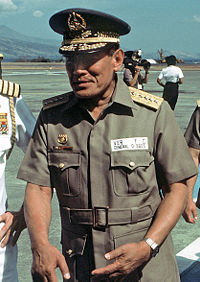“Hiya.”
Base sa akda ni Dr. Kevin Nadal na “Filipino American Psychology,” ang hiya ay parte ng kulturang Pilipino mula pa sa ating mga ninuno. Bago pa man makarating ang mga dayuhan, umiiral na ang “hiya” sa ating mga tahanan. Ngunit ang tipo ng “hiya” na kanyang isinulat ay batay sa karangalan; kumbaga tayo ay may hiya dahil gusto nating ipakita sa lipunan ang pinakamabuting bersyon ng ating sarili at pamilya.
Kaya nang mabasa ko ang mga kumento ni Teddy Locsin, napatanong ako kung nakakahiya ba talaga ang Tagalog? Nakababawas ba ito sa karangalan ng isang tao, lalo na kung sila ay Pilipino? Anong bersyon ba ng ating sarili ang ipinahihiwatig natin kapag tayo ay nagsasalita ng Ingles imbis na Filipino? Talaga bang ganoon kababa ang tingin nating mga Pilipino sa ating sarili na pati ang ating wika ay ayaw na nating bigkasin? Hindi raw angkop sa debate, hindi tunog “propesyunal,” parang nagkwekwentuhan lang sa palengke. Ganyan ba talaga ang tingin natin sa Filipino ngayon?
Nakalulungkot dahil hindi lang si Teddy Locsin ang may pananaw na ganito. Bawat uwi ko sa Pilipinas, puro Ingles na ang salita ng mga “elite” na pamilya. Para bang kapag hindi ka marunong magsalita ng Filipino ay mas mataas kang uri ng tao. Sabi ng mga magulang ngayon ay dapat Ingles ang ginagamit sa kanilang mga anak para sila ay matuto, kaya wala nang Tagalog na naririnig sa tahanan. Napakamali ng ganitong pag-iisip. Sa tingin ko ay kung may pagkakataon kang matutunan ang sarili mong wika, ay dapat mong samantalahin ito. Napakaraming Pilipino na walang oportunidad na aralin ang Filipino, na magbabayad ng ilang daang dolyar para lang makausap ang kanilang mga pamilya. Kung alam niyo lang kung gaano kahirap intindihin ang Filipino para sa iba. Kung alam niyo lang kung gaano kahirap isulat ang talatang ito kahit ilang taon ako nag-aral ng Filipino at tumira sa Pilipinas.
Ginoong Locsin (at kung sinoman ang may katulad na pananaw), sayang sa iyo ang wikang Filipino. Sayang ang karunungan mo ng wikang Filipino. Sana ay ipinagkaloob ito sa libu-libong Pilipino na gustung-gustong matuto, gamitin, pahalagahan, mahalin, ang wikang Filipino. Sana sila na lang ang nabiyayaan ng oportunidad na para bang wala lang sa iyo.
Katatapos lang ng klase ko ng kolehiyo, at ngayon, ang mga kaibigan ko noong mataas na paaralan na ang mga guro. Sana ang henerasyon namin ay magising sa halaga ng ating wika, at igiit ito sa bagong henerasyon. Nawa’y maubos ang mga Teddy Locsin ng Pilipinas at mawala na ang ating hiya sa sarili nating kultura.
(Paumanhin kung barok man, o mali ang grammar/spelling ko. Out of practice na ako, haha.)
Translation for non-Tagalog-speaking folks:
“Shame.”
According to Dr. Kevin Nadal’s “Filipino American Psychology,” shame has been a part of Filipino culture dating back to our ancestors. Before Western colonizers even arrived in the Philippines, “shame” prevailed in our households. But the “shame” that Nadal wrote about is based on honor; as in, we have “shame” because we want to show society the best version of ourselves and of our families to preserve this honor.
So when I read the comments by Teddy Locsin, it made me question what about Tagalog is so shameful? Does it dishonor a person so, especially when the person is Filipino? What version of ourselves do we really show when we speak English instead of Filipino? Do we, Filipinos, think so lowly of ourselves that we don’t even wish to speak our own language? They say Filipino is not appropriate for debate, that it doesn’t sound professional, that it’s akin to gossiping in the market. Is that really how we view Filipino today?
It is so sad that it is not only Teddy Locsin who has this point of view. Every time I go back to the Philippines, more and more “elite” families speak solely in English. It seems as though the less Filipino you know, the “higher” your rank as a human being becomes. Parents these days say we should use English around their children so they can learn, so we no longer hear Tagalog in the home. This mentality is so wrong. I personally think that if one is given the chance to learn their own language, that they should embrace it. So many Filipinos don’t have the same opportunity to learn Filipino, who pay hundreds of dollars just so they can hold a conversation with their families. If you only knew how hard it is for others to understand Filipino. If you only knew how hard it was to write this even though I studied Filipino for years and grew up in the Philippines.
Mr. Locsin (and whomever shares his point of view), the Filipino language is wasted on you. Your knowledge and skill of Filipino is a waste. If only the proficiency you possess was bestowed upon the thousands of Filipinos who would like nothing more than to learn, use, value, and love the Filipino language. If only they were blessed with the opportunities that seem to mean nothing to you.
My class just finished college, and now my friends from high school have become the teachers. I hope our generation is able to wake up to the value of our native tongue, and to emphasize this value to the future generations. That we rid ourselves of the Teddy Locsins of the Philippines and shame of our own culture.









